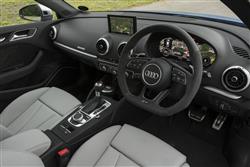How will you view?
This is a sample, showing 30 seconds of each section.
OPEN WIDER & SAY R (some text hidden) SECTIONED_new_audirs3_2018
By Jonathan Crouch
Introductionword count: 62
This improved 400PS version of the second generation 'Typ8v'-series Audi RS 3 sold between 2017 and 2020 featured the most powerful production five-cylinder engine in Ingolstadt's history. Plus there was more technology, less weight, smarter looks and a more sophisticated interior. The result was a compact performance car that claimed class-leading status and aimed once more to rewrite the shopping rocket rulebook.
Modelsword count: 6
5dr family hatch (2.5 petrol [RS3])
Historyword count: 535
Did anyone ever imagine back in 2017 that one day, a model of this size would offer what would once have been seen as supercar-style power? In this improved second generation Audi RS 3, that's just what the market got: four wheel drive, formidable pulling power and 400PS. This was more than any car of this kind had ever offered before, courtesy of an engine that really set this model apart in this segment. That wasn't only because of its total output figure. Like V8s for AMG or straight sixes in BMW M cars, a tuned five cylinder unit is part of the DNA of a division which was once called 'Quattro gmbh' but which by 2017 was known as 'Audi Sport' - the Ingolstadt brand's performance division. That of course was the configuration used for the classic Quattro coupe that first established Audi's engineering credentials back in the Eighties and the brand returned to it when at the beginning of the century's second decade, the time came to expand its RS performance model line-up. Leading the charge in that regard was this car's predecessor, the original first generation RS 3 Sportback of 2012. This model used its 2.5-litre five cylinder engine to become one of the very first hot hatches to break through the 300PS barrier, offering 341PS and what was then seen as quite shocking levels of performance. Customers loved it and Audi sold four times as many as it thought it was going to. Journalists though, didn't, criticising the car's soul-less dynamics, lifeless steering and general lack of agility. A model of this kind, they told Audi, had to be about more than just ultimate grip and prodigious speed. The 'RS' 'Racing Sport' badge deserved something better. We got exactly that in 2015 with the original version of this second generation RS 3 model. Power was up to 377PS but primarily, development was centred on improvements to the driving experience. To aid agility, the car was lightened, while at the same time, the S tronic auto gearbox and the quattro 4WD system were redeveloped for faster reactions, plus adaptive damping became optional. It ought to have been a recipe for the ultimate super hatch and would have been had it not been for the subsequent introduction of a revised, more powerful 386PS version of this car's closest rival, the Mercedes-AMG A 45. The RS 3 might have been vastly better, but it still couldn't claim complete class leadership. This significantly improved second generation design stood a better chance in that regard though. For the second generation RS version of their TT sportscar launched in 2016, Audi Sport completely redeveloped their 2.5-litre five cylinder engine and the result was a switch to a significantly lighter aluminium block and a 33PS increase in power to 400PS. The obvious next move was to stick that powerplant in the RS 3, add a few styling tweaks and re-establish its class-leading credentials. That was the thinking that's led to the creation of the model we're looking at here, also available in Saloon guise as well as in the usual Sportback body style. It sold until the end of the 'Typ8v' A3 model line's production life in 2020.
What You Getword count: 332
If you've got it, you shouldn't need to shout about it - or so Audi believes. Hence the subtlety of the changes made to Sportback and Saloon versions of this RS 3 in 2017 to differentiate them from their equally low-key S3 stablemates. As before, there was a choice of Sportback hatch or saloon body shapes. Either way, the major points of differentiation with this post-2016-era model lie at the front end where the three-dimensional black honeycomb grille lacks the bright aluminium cross-bars that feature on other A3 variants from this era and gets 'quattro' lettering along its lower edge. Underneath, a silver blade flows just above the lower splitter and turns up at either end into more purposeful-looking lower corner air intakes. Behind the wheel, it's all in the details. The flat-bottomed leather and alcantara-trimmed RS sport leather steering wheel with its contrast stitching is of course bespoke. So are the stainless steel pedals, the RS gear lever and the illuminated RS door sill trims. We really like the seats. They came in nappa leather-trimmed sports form as standard, but we'd want to find a car whose original owner had paid the extra for the brilliant winged, diamond-quilted Super Sports seats. They're anatomically-shaped and perfectly position you to view another standard cockpit highlight, the all-digital Audi 'Virtual Cockpit'. In the back, a six-footer can sit behind an equally lanky driver but it's a fairly snug fit and, as you'd expect from this class of car, three across the back only really works if the people concerned are of school-going age. The boot is 335-litres in size if you go for the Sportback variant. That's 5-litres less than you'd get in an equivalent S3 Sportback. Opting for the Saloon body style means you have to compromise quite a bit on cargo volume. Even though the trunk area is 170mm longer than that of the Sportback, the total capacity figure with that variant falls to 315-litres (down from 390-litres in a four-door S3).
To see the full road test text contact us on 0330 0020 227
Pictures (high res disabled)

.jpg)
|
.jpg)
|
.jpg)
| |||
.jpg)
|
.jpg)
|

|
Scoring (subset of scores)
Category: Sporting Cars
| Performance | |
| Handling | |
| Comfort | |
| Space | |
| Styling, Build, Value, Equipment, Depreciation, Handling, Insurance and Total scores are available with our full data feed. | |



